

From high on the stupa of Swayambunath Temple above Kathmandu the all-seeing eyes of Buddha look out over the great white wall of the Himalaya stretched along the northern horizon. Eight of the world's fourteen "eight-thousanders" ( mountains over 8000metres in height ) lie within the Hindu Kingdom of Nepal. Although it is now 49 years since the first ascent of an "eight-thousander" ( Annapurna by Maurice Herzog in June 1950 ) the approach routes to their base camps still require many days hard walking on primitive trails through medieval villages and, in many cases, across high, snow-covered passes.
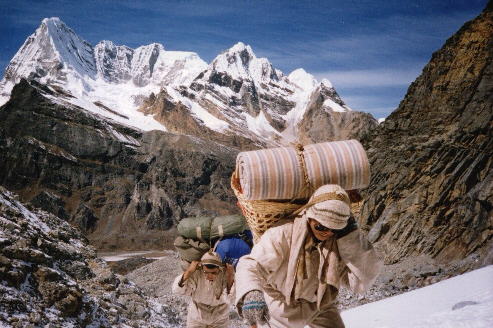 Porters crossing Mera La into the Hongu Valley |
However the network of trails linking the villages ensconced in the remote valleys of this isolated, himalayan country and the traditional porter system for transporting trade goods might well have been tailormade for today's tourists ( even would-be Everest summiteers, are categorized on their entry visas as tourists ).
The vast majority of the population eke out a subsistence level existence in small rural communities and as soon as they can walk children start to use a namro ( head strap ) and doko ( conical wickerwork basket ) to carry loads of firewood or fodder. Although yaks and ponies are used in some parts of Nepal for transporting goods the use of the namro is commonplace. Long trains of professional porters carry gigantic loads from the roadheads to markets such as Namche Bazaar, the capital of the Sherpas, high in the heartland of the Solu Khumbu. A standard load is 30 kilograms for both men and women but men can be asked to take double, or even heavier, loads. Cargo carrying helicopters are a recent threat to their business but are unlikely to replace the namro in the foreseeable future.
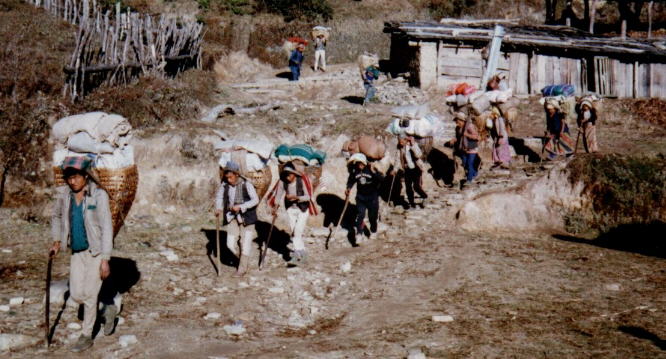 Train of professional porters trade goods to Namche Bazaar |
Many of the caravanserai and lodges used by these porters for their lunch and overnight stops have now been commandeered by independent backpackers for use in so-called "tea-shop" trekking - OK if you are immune to bed and stomach bugs. The two most popular routes, Everest Base Camp ( known as the "yak route" ) and Annapurna Circuit ( known as the "Coca Cola trail" ), can both be undertaken as "tea-shop" treks.
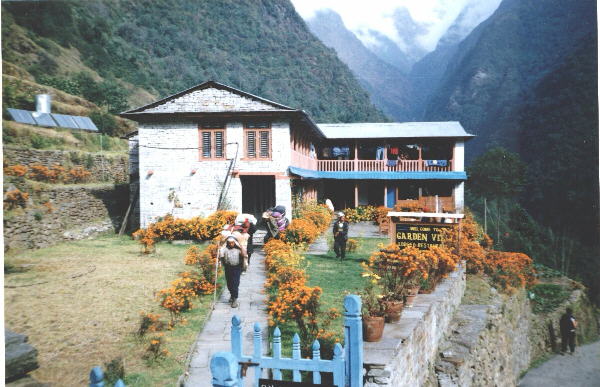 Porters at trekking lodge at in Chomrong on route to Annapurna Sanctuary |
While some consider that carrying their own rucksacs helps them to get fit and acclimatize ( not a view I share ) and others say they do not like to use people as beasts of burden I have found that many backpackers do not know how little it costs to employ a porter and would gladly do so to save sore backs, aching feet and 'sahib's knee'. None of my climbs and treks would have been possible or so enjoyable without the stalwart support and cheerful company of my porters. "Good food, better pay, more interesting and easier than other jobs", asserted Mohan and Lal Bahadur on my recent return visit to the Annapurna Sanctuary. They were happy to be employed. Usually the number of porters looking for work exceeds the number of loads available as many have come to rely on trekking for hard cash to buy supplies and equipment for their family farms.
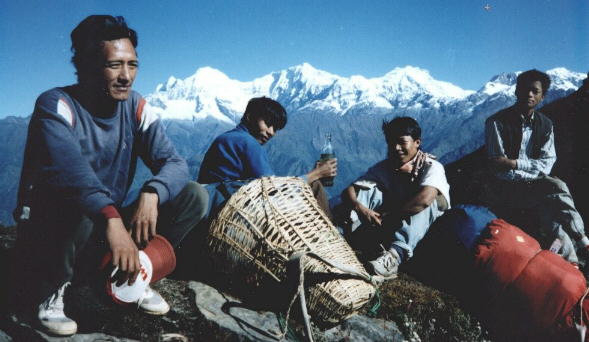 Trekking crew on route to the Ganesh Himal |
The alternative to "tea-shop" trekking is camping or "organised" trekking where each group is self-sufficient and carries its own food, camping and cooking gear enabling access to remote, uninhabited, wilderness areas such as the spectacular Hongu Valley in the Everest region and the isolated "Hidden Valley" in the Dhaulagiri Himal.
After the first few days the routine becomes well established:- bed tea, washing water - kitbag packed, tent down - porters off - breakfast - trekking - rest stop - trekking - lunch stop - trekking - rest stop - trekking - set up camp.
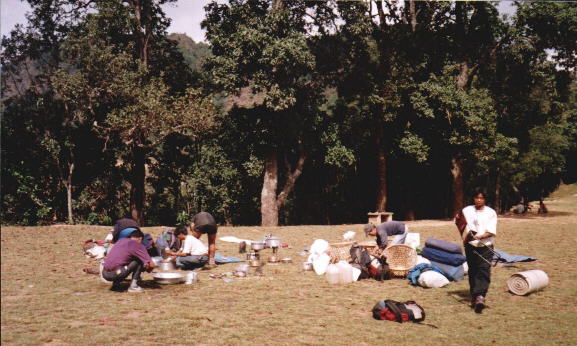 Trekking crew establishing camp at Chautara on route to the Jugal Himal |
On my first trek I was amazed, and relieved, at the variety and quality of the meals produced by our cook, Dendi, and his kitchenboys from his open, wood fires - a trekking group, like an army, marches on its stomach - indeed it was a British army officer, Colonel Jimmy Roberts, who pioneered and established trekking in Nepal. His training is still in evidence - cooking utensils are cleaned and polished before and after all meals and periodically layed out for inspection.
Trekking staff usually start off as porters and work their way up to the top job of sirdar - the foreman in charge of a trekking group. My friend Ang Zangbu, the managing director of Highland Sherpa Trekking, began his career as a porter before serving his apprenticeship as kitchenboy, cook and sirdar.
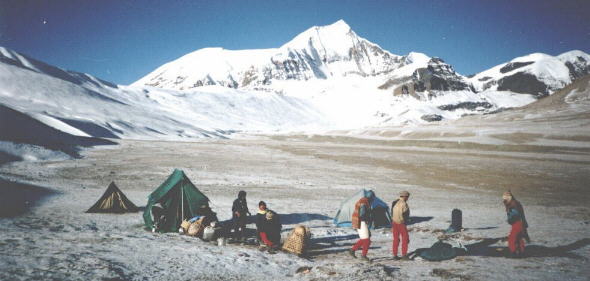 Well
clothed porters at camp in The Hidden Valley |
Porters are the least well equipped for high level treks and the better agencies provide them with warm clothing and footwear. Many do not and porters have frozen to death on the high passes. They are however the backbone of all major treks and climbing expeditions - even the redoubtable Reinhold Messner, the first person to make solo ascents of all 14 of the world's eight-thousanders, used porters to reach his base camps.
( The Commentator, The ( Glasgow ) HERALD, Saturday 17th October 1998 )
Himalaya Map - Nelles ( UK , USA )
Nepal Trail Map - Nelles ( UK , USA )
Everest Base Camp Map ( UK , USA )
Khumbu Region Map ( UK , USA )
Island Peak - Climbing Map ( UK , USA )